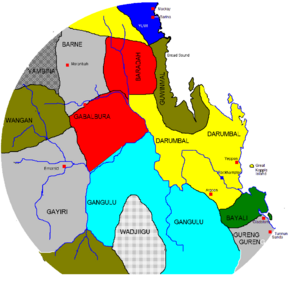Koinmerburra people facts for kids

The Koinmerburra people are an Aboriginal Australian group from Queensland. They are also known by names like Koinjmal, Guwinmal, and Kungmal. These people are the traditional owners of land that includes part of the amazing Great Barrier Reef.
Contents
Traditional Lands
The Koinmerburra people's traditional lands covered about 1,600 square miles (4,144 km²). This area stretched from the western slopes of Pine Mountain in the Normanby Range to the Styx River.
They lived along the coast from Broad Sound north to Cape Palmerston. Their land also included St. Lawrence. Inland, their territory reached the Coast Range. To the south, it ended near Marlborough.
The Koinmerburra people used the large mangrove mudflats in their area. They used bark canoes to travel through these coastal waters.
Community Life
The Koinmerburra people lived in different kin groups. These are like family groups. We know the names of at least two of these groups:
- Mamburra
- Bauwiwarra
An early person from Rockhampton, W. H. Flowers, shared information about the Koinmerburra. He said they had two main groups called moieties. These were the Yungeru and the Witteru. Each moiety was then split into two smaller sections. This created four main sub-classes.
The Yungeru moiety had two parts:
- The Kurpal, whose special animal (totem) was the Eagkehawk.
- The Kuialla, whose totem was the Laughing jackass.
The Witteru moiety was divided into the Karilbura and Munaal. These groups had several totems, including the wallaby, Curlew, Hawk, Clearwater, and Sand.
Marriage Customs
Marriages were sometimes arranged when girls were young. A girl's parents would arrange her marriage to an older man. After this promise, the man would regularly provide her with food like game and fish. He would also respectfully avoid her parents' camp and not speak to her mother.
The marriage ceremony had special steps:
- The girl's parents would paint her and decorate her hair with feathers.
- Her male cousin would then take her to her future husband, who would be sitting quietly.
- The cousin would seat the girl behind her future husband.
- After some time, the cousin would take the feathers from her hair and place them in the husband's hair.
- Then, the girl would be led back to her parents.
A symbolic part of the marriage ceremony involved the young girl. When her father felt she was old enough, he would send her with other women to gather food. He would then tell the man she was promised to. The man would paint himself, take his weapons, and follow her. He would invite all the unmarried men to help him.
When they found the women, the man would go forward alone. He would tell the girl he had come for her and take her by the wrist or hand. The other women would try to keep her from him. The girl would also try to escape. If she did not want to marry him, she would bite his wrist. This was a clear sign that she refused the marriage.
History
At the start of the 20th century, some Koinmerburra family groups were living outside their traditional lands. They were found in places like Yaamba and Bombandy. This happened because white settlers moved into their homeland. This forced the Koinmerburra people to move south from their original territory.
Language
The language of the Koinmerburra people is called Guwinmal. It is an extinct dialect of the Darumbal language. This means it is no longer spoken today.
Other Names
As of 2020, the most common name for these people is Koinmerburra. However, they have been known by many other names, including:
- Koinbal (meaning people of the plains)
- Kooinmerburra
- Kuinmurbura
- Kungmal
- Kungalburra
- Kuinmabara, Kungalburra, Gunmal, Koi, Kweembul, Kwiambal, Kwigalburra, Mamburra, Queenbullaquieumble, Gunymal, Gonjmal, Kuinmur bura, Koinjmal
Some Words
- kuinmur means "a plain."
Caring for the Land
A special group called the Traditional Owner Reference Group helps manage natural resources. This group includes representatives from the Koinmerburra people, along with the Yuwibara, Barada Barna, Wiri, Ngaro, Gia, and Juru people. Their lands are within the Reef Catchments Mackay Whitsunday Isaac region.
This group helps to support natural resource management. They also look after important cultural heritage sites in the area.

